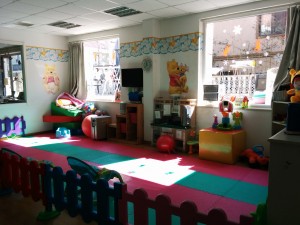最近, 我有难得的好机会在小花寄养院做自愿工作。小花寄养院养父母买不起孩子的意愿费的有厉害病症小孩子。小花寄养院跟医院合伙以治疗疾病然后让小孩子回家,在社会融合。
每个星期我帮助喂食在小花寄养院的婴儿以及跟比较大的孩子玩儿。虽然大部分的孩子有厉害损伤 – 最多的是心血管疾病 – 小花寄养院尽量合作让他们的生活快乐。小花寄养院非常干警,非常欢迎性,为了创造好像家庭的气氛,有几个一对夫妇住在小花寄养院充当父母。
做自愿工作显然很好玩儿,也让我感觉我做一件好事,在寄养院也透露中国医疗保健的制度怎么样。可能表示中国社会的许多矛盾,中国医疗保健完全不跟我设想的相同。虽然百分之九十五的中国人有医保,大部分的医院设在私营,以前支付的模式。
虽然近几年1990年代改革以后医疗保健水平逐年提高,面对医疗保健制度最厉害的问题还是农村和城市的差距。有的医院成为开拓性研究,以及许多在城市医院使用现代的技巧和设备。不过在贫穷的农村,医院厉害地落后发达国家的水平。并且,许多住在农村人买不起基本保健。
这是小花寄养院正在试着缓解的问题。由于住在农村的孩子可不到或父母买不起即使基本保健手续,他们的前途茫茫的。虽然最近的改革帮助减少城市农村的医疗保健差距,解决问题的方法只是通过减少更大的城市农村的生活水平差距。
不巧由于保护孩子的原因,我不能上传莫壮孩子的照片,但是在http://chunmiaolittleflower.org/ 发现更多信息和照片。
ENGLISH TRANSLATION:-
Volunteering at Chunmiao Little Flower home
Over the last few weeks, I’ve been lucky enough to have the chance to do some volunteering at Chunmiao little flower baby and children’s home. The home takes in severely disabled babies and children from all over China, whose parents can’t afford the healthcare costs of looking after them. Paired with a local hospital, the home gets them medical treatment and with the long term aim of sending them back home into the community.
I spend time each week helping to feed and look after the resident babies, and play with the older children. While most of the children are very severely disabled, most commonly with cardiovascular problems, Chunmiao home tries to make their lives as good as possible. The home itself is incredibly clean and welcoming, and there are live-in couples who act as adopted parents to the children to create a family atmosphere.
While volunteering is obviously very enjoyable and rewarding, it also reveals a lot about the healthcare system in China. Perhaps representative of the many contradictions of Chinese society, healthcare provision is not at all what I expected for such a nominally socialist country. While 95% of the Chinese population have health insurance, most hospitals and clinics are run on a private, upfront-payment model.
While standards have improved drastically in recent years since reforms in the 1990s, the main problem facing the system is the rural-urban disparity. Some hospitals in Beijing have become pioneering research centres, and many urban hospitals use modern techniques and equipment. On the other hand, hospitals in poor rural areas lag far behind the standard set by the developed world, and many people in the countryside cannot afford even basic healthcare provision.
This is the problem that Chunmiao home is attempting to alleviate. Many rural children with long term health problems have bleak futures as even the most basic lifesaving medical procedures that they need aren’t available where they live or are prohibitively expensive for their parents. While recent reforms are attempting to bridge the rural-urban healthcare disparity, the problem will only be solved once the wider rural-urban wealth divide is narrowed.
Unfortunately I can’t upload photos of the children themselves for child protection reasons, but visit the home’s website at http://chunmiaolittleflower.org/ for more information and photos.

